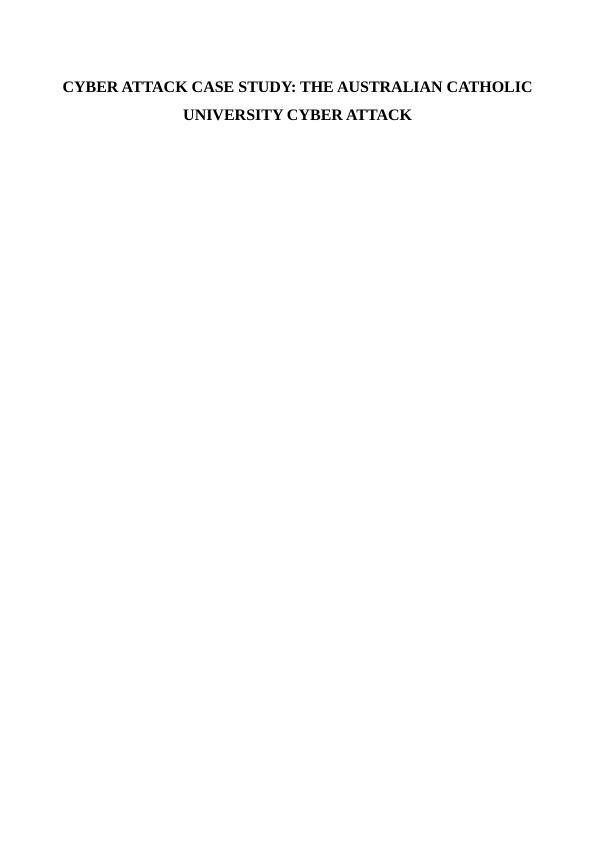Cyber Attack Case Study: The Australian Catholic University Cyber Attack
Added on 2022-11-25
4 Pages791 Words279 Views
CYBER ATTACK CASE STUDY: THE AUSTRALIAN CATHOLIC
UNIVERSITY CYBER ATTACK
UNIVERSITY CYBER ATTACK

What happened
The attack on the Australian Catholic University involved the hacking and theft of sensitive
personal information belonging to its staff; the event is reported to have taken place on may 22nd
2019. The attack was executed using phishing, resulting in several e-mail accounts belonging to the
affected staff and some of the university’s systems being compromised. The attacks resulted in the
log-in details of some staff being obtained and used in accessing the e-mails of the staff, in addition
to their bank details and calendars (Fellner, 2019).
Role of Law Enforcement
The law Enforcement were given a report of the cyber attack, including the Office of the Australian
Information Commissioner (OAIC) and the Australian Cyber Security Center. The crime falls
under the jurisdiction of the Australian Federal Police and they work with Local Law Enforcement
authorities to deal with cyber crimes. Unlike normal crime cases such as theft, the Australian law
Enforcement Agencies (Federal and State) work with other organizations such as the Australian
Cyber Security Center (Australian Catholic University, 2019). The Queensland Police Service has a
dedicated cyber crimes unit and were responsible for taking the report, available evidence, and
opening an investigations file into the cyber attack (Stewart, 2019).
Variation with Traditional Law Enforcement
The same principle is used in investigating traditional crimes and cyber crimes; it is based on the
victim, the evidence, and suspect making physical exchanges that create a link to the crime. The
evidence in cyber crimes, however, include digital artifacts, such as digital pictures, social media
site activity, IP (Internet Protocol) addresses, and other files of a digital nature. Investigating cyber
crimes also involves close collaboration with other entities other than law enforcement, such as data
recovery experts and firms that can be roped in to help find evidence (Sherry et al., 2015). The
crime ‘scene’ shifts from the physical environment to the ‘cyber/ digital’ environment and can
sometimes go across borders to other jurisdictions.
Effect of the Cyber World
The cyber world makes near-impossible to know for sure the perpetrators behind the attack and its
origins. Attackers can use fake IP addresses and the fact that evidence is digital rather than physical
(such as DNA samples) means finding the source of the attack is very difficult; the computer used
in the attack could have been used from a public access point and thereafter destroyed, making all
evidence unavailable (Stewart, 2019; Rogers, 2016). Attackers employ obfuscation technologies
that disguise their IP addresses; these obfuscation tools are legal and generally free- it is therefore
difficult to track and trace the sources of the attack.
Resources that Could have Assisted law Enforcement
The attack on the Australian Catholic University involved the hacking and theft of sensitive
personal information belonging to its staff; the event is reported to have taken place on may 22nd
2019. The attack was executed using phishing, resulting in several e-mail accounts belonging to the
affected staff and some of the university’s systems being compromised. The attacks resulted in the
log-in details of some staff being obtained and used in accessing the e-mails of the staff, in addition
to their bank details and calendars (Fellner, 2019).
Role of Law Enforcement
The law Enforcement were given a report of the cyber attack, including the Office of the Australian
Information Commissioner (OAIC) and the Australian Cyber Security Center. The crime falls
under the jurisdiction of the Australian Federal Police and they work with Local Law Enforcement
authorities to deal with cyber crimes. Unlike normal crime cases such as theft, the Australian law
Enforcement Agencies (Federal and State) work with other organizations such as the Australian
Cyber Security Center (Australian Catholic University, 2019). The Queensland Police Service has a
dedicated cyber crimes unit and were responsible for taking the report, available evidence, and
opening an investigations file into the cyber attack (Stewart, 2019).
Variation with Traditional Law Enforcement
The same principle is used in investigating traditional crimes and cyber crimes; it is based on the
victim, the evidence, and suspect making physical exchanges that create a link to the crime. The
evidence in cyber crimes, however, include digital artifacts, such as digital pictures, social media
site activity, IP (Internet Protocol) addresses, and other files of a digital nature. Investigating cyber
crimes also involves close collaboration with other entities other than law enforcement, such as data
recovery experts and firms that can be roped in to help find evidence (Sherry et al., 2015). The
crime ‘scene’ shifts from the physical environment to the ‘cyber/ digital’ environment and can
sometimes go across borders to other jurisdictions.
Effect of the Cyber World
The cyber world makes near-impossible to know for sure the perpetrators behind the attack and its
origins. Attackers can use fake IP addresses and the fact that evidence is digital rather than physical
(such as DNA samples) means finding the source of the attack is very difficult; the computer used
in the attack could have been used from a public access point and thereafter destroyed, making all
evidence unavailable (Stewart, 2019; Rogers, 2016). Attackers employ obfuscation technologies
that disguise their IP addresses; these obfuscation tools are legal and generally free- it is therefore
difficult to track and trace the sources of the attack.
Resources that Could have Assisted law Enforcement

End of preview
Want to access all the pages? Upload your documents or become a member.
